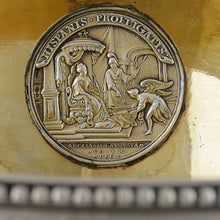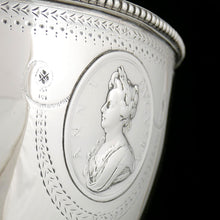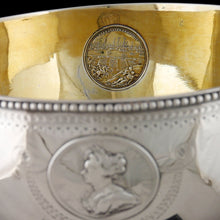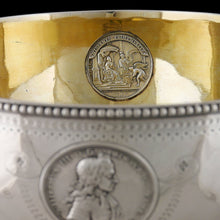The Glorious Revolution & War of Spanish Succession - Rose Bowl, 1784
- Regular price
- £6,400
- Sale price
- £6,400
- Regular price
-
- Unit price
- /per
Adding product to your cart
Diameter: 23.8cm (9.4in). Height: 21cm. Weight: approx 1900 grams.
Silver and silver gilt. George III rose bowl on a spreading foot, with gadrooned and bright-cut decoration; the body inset with two medallions; the first by George Bower in silver gilt commemorating the Landing of William III at Torbay in 1688; the second by J. Croker also in silver gilt commemorating the Battle of Saragossa in 1709. The bowl with gilt interior. Maker’s mark of Thomas Chawner. Hallmarked London 1784. Raised on later stepped base.
The present rose bowl commemorates the Glorious Revolution of 1688 and the military victory of 1709 by which James, Lord Stanhope launched his political career to become George I’s chief minister and, in all but name, Britain’s first prime minister. Bower’s and Croker’s medals thus commemorate significant events on the path to the so-called Whig Supremacy - the period of history from 1714 to 1760 that saw Whigs dominate English political life at the expense of Tories who were suspected of harbouring Jacobite sympathies and capable of supporting treasonable activity towards the Hanoverian succession. Moreover the hallmark date of 1784 neatly bookends the half-century long so-called Whig Oligarchy of 1714-1783.
Read more
The reverse of George Bower’s medal shows the equestrian figure of the Prince William of Orange at the head of his Dutch army drawn up on a West Country beach on 5 November 1688. Ships at anchor in distance, and with the fainting figure of Justice on a cliff to the right being raised up by a cuirassier, all in all a neat summary of the unopposed landing that led to a crucial milestone in the development of England’s constitutional monarchy.
William was invited by seven leaders from both Houses of Parliament to England to defend the rights and liberties of the people against the tyrannical King James II who sought overthrow the Church of England and reintroduce Roman Catholicism. Hitherto, the Tories (pejoratively named after Irish robbers and highwaymen) were the staunch supporters of an absolutist Stuart monarchy. Their opponents, the Whigs (named after the derogatory Gaelic ‘whiggamor’ term applied to troublesome Presbyterians in Scotland|) resisted Court influence in Parliament, particularly its attempts to secure votes through bribes and patronage. Whigs and Tories are thus seen by some as the embryonic beginnings of the English two party system.
The success of the Glorious Revolution of 1688 was secured even before William reached Exeter whereupon all support for James II evaporated and he fled the country for France. William, a grandson of Charles I, took the throne jointly with his wife Mary, daughter of James II. The 1688 Revolution was duly solemnised by Parliament with the declaration of a convention which included the passing of several important acts that included the Bill of Rights, and one to ensure Parliament’s complete control of the Army. Whiggism with its doctrines of constitutional monarchy was to become associated with aristocracy and the financial interests of the wealthy middle classes, while the Tories, as generally favoured by Queen Anne (1702-14), were represented by the squirearchy who were generally resistant to constitutional change, religious toleration and foreign entanglements.
Britain’s in involvement in the War of the Spanish Succession (1702-1713) was a case in point. The death of the Charles II of Spain ignited a war between his heirs, Archduke Charles V of Austria and Phillip of Anjou, for control of the Spanish empire. To prevent French control over much of Western Europe, Britain joined the Grand Alliance of 1701 in support of Archduke Charles. The Duke of Marlborough, a moderate Tory, was appointed Captain-General of the Allied forces in the Spanish Netherlands and delivered a series of stunning victories at Blenheim, Ramillies, Oudenarde and Malpaquet. Later Allied successes in Spain at the battles of Almenar and Saragossa on 20 August 1710 enabled Archduke Charles to enter Madrid, and gave comfort to the Whig ministry at home if not to a war weary public. The reverse of Croker’s Saragossa medal strives to convey the scale of the defeat inflicted by Lord Stanhope with an allegory of Victory, being introduced by Britannia, presenting three (of 73) captured Bourbon standards to Queen Anne who sits enthroned on a dais.
On the back of these victories, Stanhope was selected as the Whig candidate for Westminster at the 1710 general election. Westminster had a relatively large electorate of over 10,000 and its proximity to both Court and Parliament meant the result there often influenced others. The Spanish victories were used to promote 'brave, virtuous Stanhope' but the Tory opponent won easily, aided by the satirist Jonathon Swift who railed against the enormous cost of the war and published thinly disguised accusations of Stanhope's homosexuality. The Tories won the 1710 General Election in December by a landslide, by which time Stanhope was a prisoner of war in Spain.
Stanhope was finally released in 1712 entered Parliament as the Member for Wendover. As a leader of the Whig opposition, he fiercely opposed the terms of the Treaty of Utrecht (1713) by which Britain unilaterally made peace with France and abandoned the Allies. The death of Queen Anne in 1714, however, brought the Hanoverian George I to the throne and election victory with a huge Whig majority for Stanhope and his former school fellow Robert Walpole. Stanhope was active in holding former ministers to account over the Treaty of Utrecht and was active in crushing the Jacobite Rising of 1715 causing leading Tories to be imprisoned or to flee into exile due to their perceived support of the Old Pretender James Stuart.
Stanhope served George I admirably as foreign minister utilising his wide European experience in a way that enabled Walpole quietly to consolidate British internal prosperity. In early 1721 Stanhope was defending his government over the South Sea Bubble scandal, for which he was partly responsible but from which he did not profit, with customary vigour in House of Lords when he was taken ill with a violent headache. After some apparent recovery the following day, he died that evening. The King was shocked and distraught and ordered Stanhope be given a full military funeral through London. He was afterwards privately buried at Chevening - the estate in Kent gifted to the nation by his descendants that today usually serves as a residence for the Foreign Secretary.












